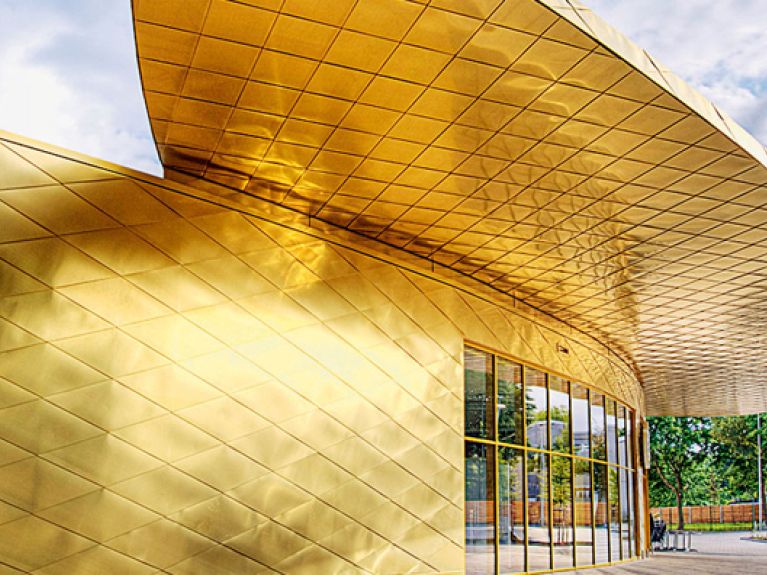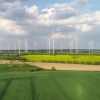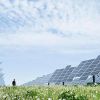Sevenfold future
Germany is focusing on sustainability in many places: seven good examples with potential for the future.

ALPHA VENTUS
A new age for renewables began on 27 April 2010 with a press of the yellow button. The giant rotors at Alpha Ventus – Germany’s first offshore wind farm – started feeding electricity into the grid on the mainland through undersea cables in the North Sea. Alpha Ventus is a 250 million euro pilot project that provides enough power for 50,000 households – and is also a technological masterpiece. Twelve wind turbines with outputs of five megawatts each have been installed in the rough climate on the high seas 45 kilometres off the coast of Borkum Island. The foundations of the wind turbines stand in water that is 30 metres deep, and the distance to the rotor blade tips is 150 metres; the nacelle, rotor and hub collectively weigh more than 400 tonnes. The German government also has ambitious plans. By 2030, 25,000 megawatts of wind power capacity is to be installed in two dozen offshore wind farms in the North Sea and Baltic Sea. Under favourable wind conditions, they will generate more than twice as much electricity as Germany currently receives from nuclear power plants. Overall, hydro power, wind power, solar power and biomass currently generate 20% of the country’s electricity, and that figure is set to increase to at least 35% by 2020.
UN climate Secretariat
Germany is a pioneer in climate protection. After the 1992 Earth Summit in Rio, where the Climate Change Convention was adopted, it was therefore only logical for the Federal Government to declare its willingness to host the UN Climate Secretariat’s headquarters. At the 1995 Climate Summit in Berlin, which was chaired by Angela Merkel, the then Federal Environment Minister and current Federal Chancellor, it was indeed decided to have the headquarters located in Germany. Since 1996, the Secretariat has been based in Bonn and now has some 200 staff members. Over the course of 2012, it will be moving to the new UN Campus, where the German Bundestag used to meet.
Kyoto, Bali, Copenhagen and Durban are just a few of the past venues for the global climate summit, which takes place each autumn and is organized partly by the Secretariat in Bonn. As many as 35,000 people now attend these mega-conferences, which draw the most public attention. However, the duties of UN climate staff in Bonn are much broader. They ensure that information is constantly sharedbetween the 194 member states of the UN Framework Convention on Climate Change and that data on greenhouse gas emissions are collated and made available; they also monitor the enforcement of the complex Kyoto Protocol. Since 2010, Costa Rican Christiana Figueres has headed the UN Climate Secretariat. For Figueres, the appointment meant a return to the Rhine. She began her career in the 1980s at Costa Rica’s embassy in Bonn, which was the German capital at the time.
B.A.U.M.
Adidas, Bosch and Siemens Appliances, Deutsche Telekom, and Rapunzel organic food – what do these companies and some 600 others have in common? They are all members of Europe’s largest environmental initiative for industry, the German Environmental Management Association (B.A.U.M). Founded as a non-profit organization in Hamburg in 1984, the association links economic, ecological and social issues and assists its members in matters pertaining to energy conservation, climate protection, and resource consumption. For instance, B.A.U.M.’s Industry and Climate project maintains a database showing the wide range of ways that member companies have reduced carbon emissions. In the competition for the “most bike-friendly employer”, the initiative is attempting to establish bicycles as the “most climate and environmentally friendly means of local transport”.
The large number of awards that B.A.U.M. has received for this campaign are a sign of the positive feedback. For instance, the campaign was included in the United Nations Global 500 Roll of Honour and also received the German Environmental Prize; B.A.U.M.’s “Solar – na klar!” campaign also impressed the European Commission.
FRAUNHOFER ISE
In the past few years, solar power production has boomed in Germany. One of the reasons for this success has been the Renewable Energies Act (EEG) of 2000. Another chapter in this success story has been written by scientists and engineers conducting high-tech research – for example, the experts at the Fraunhofer Institute for Solar Energy Systems (ISE). Based in Freiburg, the institute researches and develops concepts focusing on how solar energy – not just for electricity, but also heating and cooling applications – can be made less expensive, better integrated in the overall energy supply and optimally stored. It is the largest solar energy research institute in Europe with some 1,100 staff. The development of greater efficiencies for common silicon-based solar cells is one focal point of their work. In addition, they also look into other photovoltaic technologies, such as organic and pigment cells. The institute is part of Fraunhofer’s Energy Alliance, which brings together the competence of 16 Fraunhofer institutes working on energy technologies and research. Their goal is to collectively offer strategies and solutions to industry and the energy sector. Naturally, ISE is not only a founding member, but also headquarters Fraunhofer’s Energy Alliance.
ALPSTAR
Launched in 2006 by the International Commission for the Protection of the Alps, Alpstar’s slogan is “Make the Alps climate-neutral”. Pilot regions in all of the Alpine countries are working towards this goal. The shared vision is for every region to source all its energy locally. Efficient energy consumption and the switch to green energy sources are to make this goal attainable. Alpstar plans to develop, collect and assess best practices for climate protection in the Alps. Germany’s Achen Valley in Bavaria is involved. Located at the northern rim of the Bavarian Alps between Munich and the Austrian city of Salzburg, it is a natural and cultural landscape with lakes, streams, mountains, meadows, forests and marshes.
The communities of the Achen Valley founded Ökomodell Achental as a non-profit organization in 1999 to protect biodiversity and make the area attractive for recreation. In addition to the regional switch to renewables – the area is to be energy-independent by 2020 – the association also aims to protect small local farmers and promote businesses and tourism focusing on environmental impact. The first milestone came in 2007, when the Achental biomass facility opened, where local wood products are processed and sold within the region. As a result, a lot of homeowners, hotels, and public buildings have switched to wood-fired heating systems.
LAMMSBRÄU
German beer continues to have a good image. One reason is the German Beer Purity Act of 1516 that specifies that only hops, malt, yeast and water may be used in the brewing process. Founded in 1628, the Lammsbräu brewery in Neumarkt has been a family-owned business since 1800 – and makes a very special beer. Lammsbräu beer and all of the other drinks produced by the company are made entirely with ingredients from organic farms. In the 1980s, company owner Franz Ehrnsperger switched to organic products when he realized that the increasing use of artificial fertilizers and pesticides was reducing the quality of the ingredients he was using to make beer. Ehrnsperger came up with a seamless sustainability strategy for his firm – from raw materials to production and bottling. The brewery now gets all of its raw materials locally from 4,000 hectares of organically managed farmland. Of all organic breweries, Lammsbräu has the greatest sales worldwide; the beer is sold not only locally, but also nationally in organic shops. The firm currently has some 90 employees. The organic firm’s guaranteed sales also secure good incomes for roughly 100 organic farmers, who earn above the normal agricultural average because Lammsbräu is prepared to pay more for its raw materials.
VDI-ZRE
Whether it is cars, beverage cans, pizza boxes, paper for publications, concrete for road construction or oil for heating, enormous flows of materials are set in motion to meet human needs in industrialized countries. According to the Wuppertal Institute for Climate, Energy and the Environment, some 75 tonnes of resources are consumed per capita every year in Germany if we take into account a product’s complete lifecycle from raw material production (such as mining) to waste disposal. But the researchers also showed that the same services can be provided over the long term with only one tenth of the resources (Factor 10 concept) – in other words, much more efficiently and with far less of an impact on the environment and the climate. The Federal Government has also made increasing resource efficiency an important goal in its economic and environmental policy, as specified in its National Resource Efficiency Programme of 2011. Resource efficiency increases competitiveness, promotes innovation, protects jobs, and reduces the impact on the environment. Small and medium-sized firms in particular can be pioneers of these developments. To do so, however, they have to know more about their options and opportunities in saving raw materials – a task that the Resource Efficiency Centre at the Association of German Engineers (VDI-ZRE) has set for itself in cooperation with the Federal Environment Ministry.
The centre provides expert advice on a wide range of issues – from mechanical engineering to economics, biology, forestry and administration. For instance, it provides information on how power costs for lighting can be reduced by 90%, how to make do with less paint for components and how to achieve a twentyfold increase in efficiency in the production of compressed air. As the VDI-RZE puts it, “The implementation of efficiency measures can lead to measurable financial savings for companies, even in the relatively short term.” ▪

